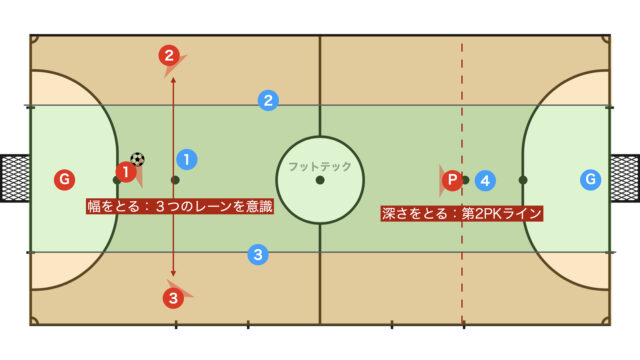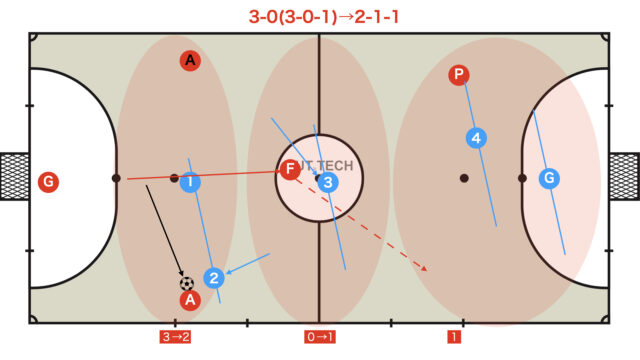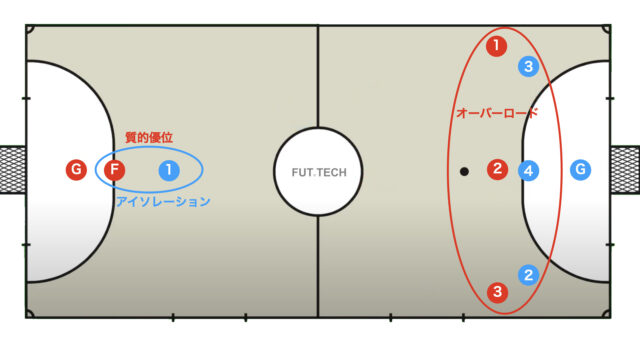This article explains the “Quattro,” considered one of the most challenging tactics in futsal.
The Quattro in futsal includes various types of rotations, making it difficult to understand even when watching F-League and overseas matches.
However, this article provides a detailed explanation of the benefits and drawbacks of the Quattro, types of rotations, and training menus.
By reading this article, you will significantly deepen your understanding of the Quattro in futsal.
Although it has become a rather voluminous article, I hope you will read it to the end.
It’s “Quattro” and not “Quattro”.
“Quattro” means four in Spanish, and the word “quarter” also derives from this.
- What is Futsal Quattro?
- Types of Quattro Rotations
- The Four-Lane Theory, a Basic Principle of Quattro in Futsal
- ② Quattro with Axis (Three-Player Rotation with Fixed Fixo)
- ④ Four-Player Rotation in Quattro
- Training Menu for Quattro in Futsal
- [Column] Duo Relationships Are Essential in Futsal Quattro
- Conclusion
What is Futsal Quattro?
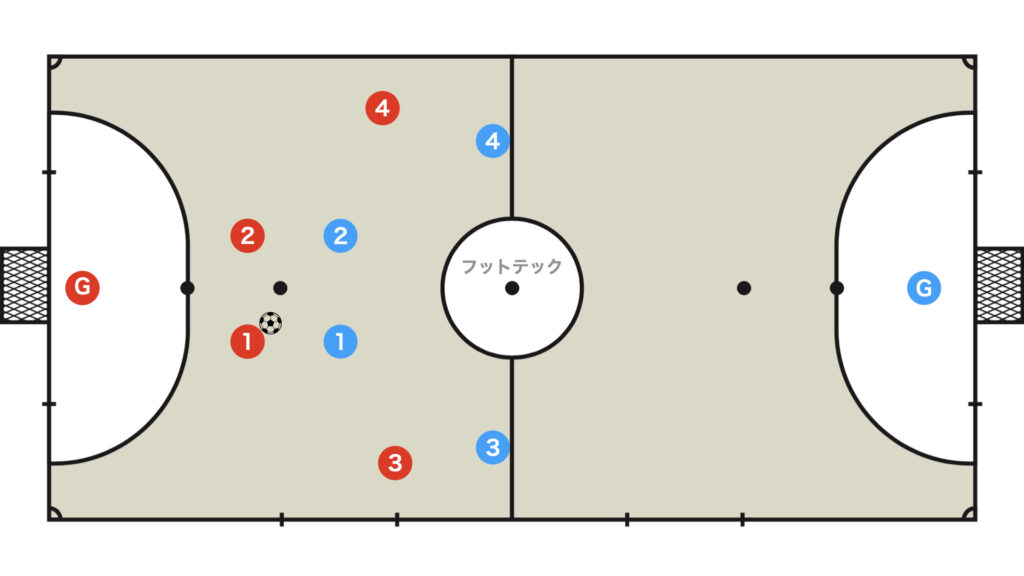
In futsal, the Quattro is a formation where four players are positioned in the back as shown above.
The characteristic of the Quattro is that no field players are positioned at the front.
Therefore, the Quattro has the following benefits:
- With a vast space in front, it is easier to succeed in breaking through.
- The fluid movement of the four players can confuse the opposing defense.
However, the Quattro requires fluidity as there is little space in their own area, necessitating high levels of stamina, technical skill, and tactical understanding.
Some teams use formations like 4-0, 2-1-1, or 3-1 depending on the attacking zone, specifically using 4-0 only for evasion and changing to 3-1 after crossing the halfway line.
Even for teams without a pivot, the Quattro is indispensable, but teams with a pivot can expand their tactical range by playing from their own half, making the pivot valuable even in a Quattro formation.
Types of Quattro Rotations
There are various movements in the Quattro, known as rotations.
While it is difficult to completely categorize Quattro rotations, they can be broadly divided into four types.
- Two-player rotation
- Three-player rotation with fixed fixo (Quattro with axis)
- Three-player rotation with fixed side (Three-player rotation)
- Four-player rotation
The ratio of rotations used varies by team, but in Quattro, these four rotations are mixed or repeated to aim for the goal.
This article thoroughly explains these four types of rotations.
The Four-Lane Theory, a Basic Principle of Quattro in Futsal
Although Quattro rotations are broadly divided into four types, there is a basic principle common to all rotations.
This is the four-lane theory in Quattro.

In all Quattro tactics, it is crucial to divide the pitch into four vertical sections (5m×4) and ensure one player is in each lane to maintain floor balance.
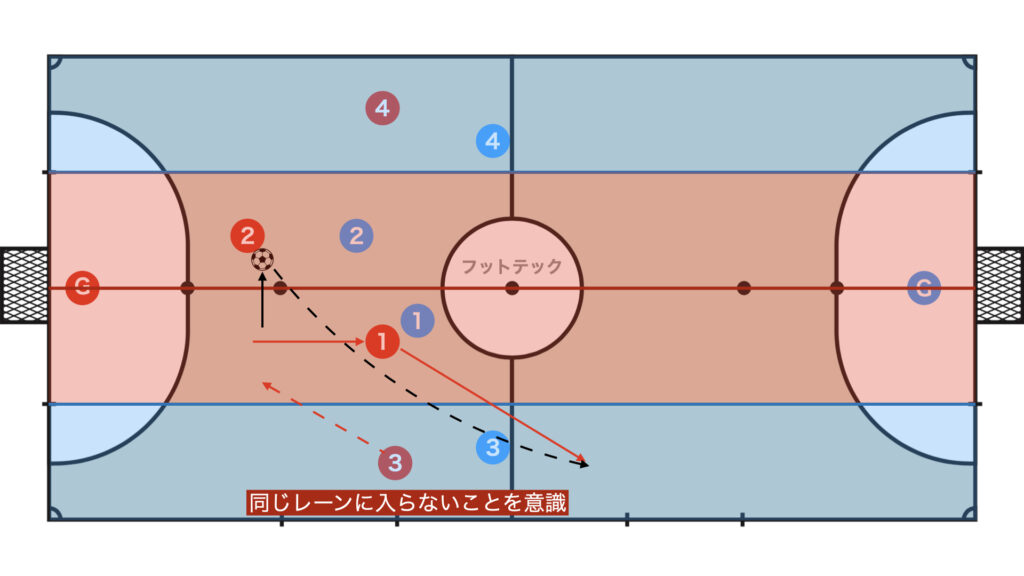

If two players enter the same lane, one should move to another lane to restore floor balance. In the image above, Red 1 recognizes that Red 3 slides to the position originally held by Red 1 after a diagonal movement.
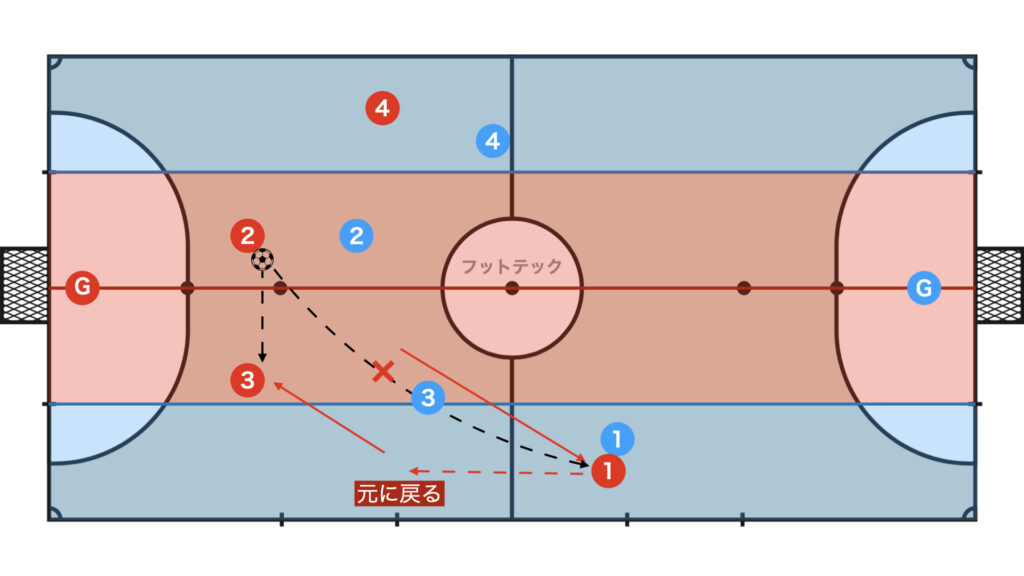

If a pass cannot be made to Red 1 after a diagonal movement, Red 1 returns to the back and resumes the original position.
https://futsal.tech/positional-attack/formation/① Two-Player Rotation in Quattro
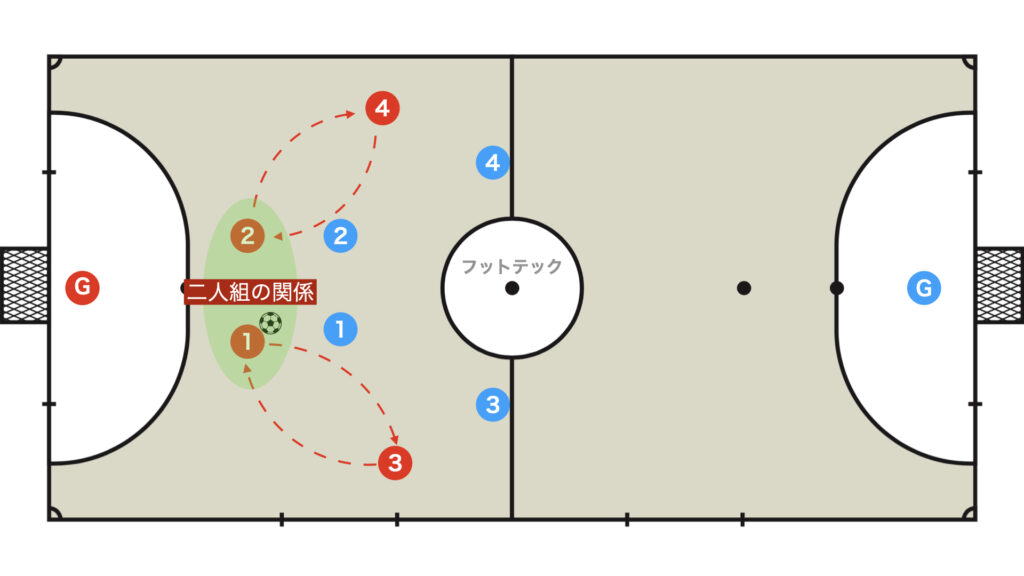

The two-player rotation involves adjacent ala and fixo switching places, continuously creating a duo relationship with two fixos.
- Backdoor (one-two)
- Diagonal
- Paralela (middle parallel)
Diagonal is a situation introduced in the basic principles.


This kind of one-two play in the center lane with two fixos is called a middle one-two.
The two-player rotation is the simplest and easiest for beginners to understand among all Quattro rotations, making it an excellent introduction but easily readable by opponents, so higher-level teams rarely use it alone.
However, it may be used partially in combination with other rotations.
Double Breakthrough
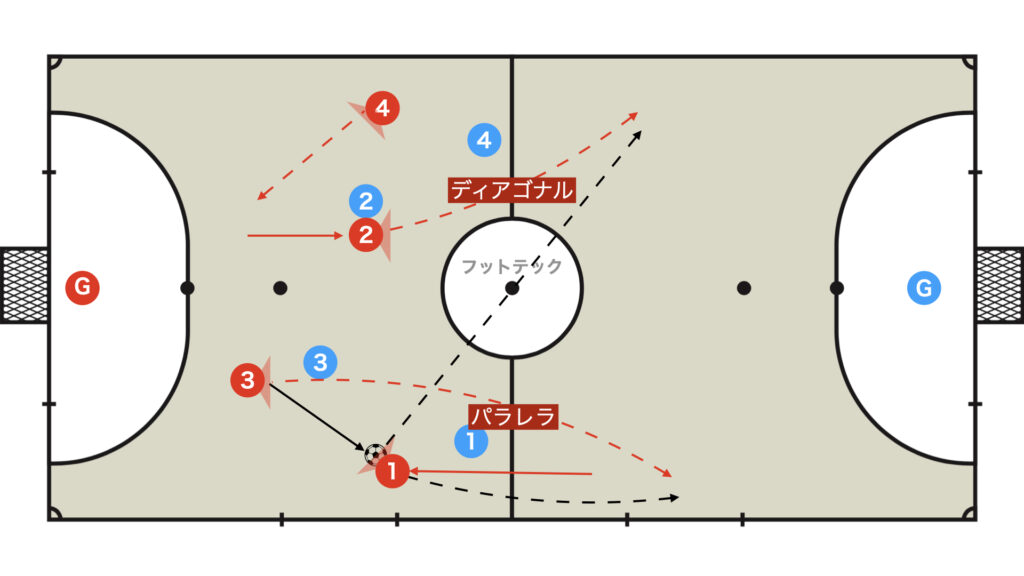

A double breakthrough is a very effective offensive action in Quattro.
This is because it creates two passing lines at the front and prevents the opponent’s defense from covering.
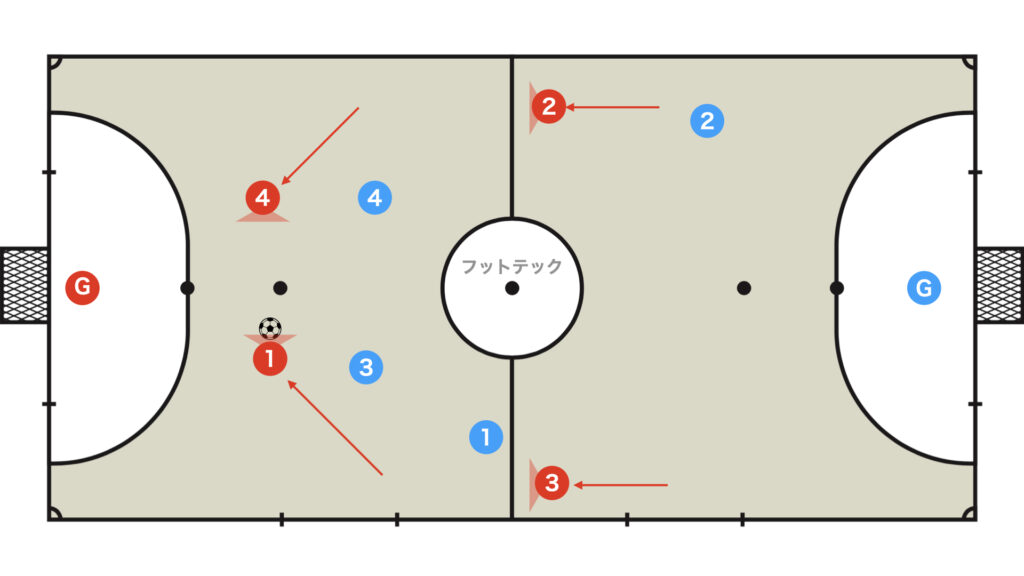

If a pass cannot be made behind, restore the floor balance and return to the original position.
② Quattro with Axis (Three-Player Rotation with Fixed Fixo)
The three-player rotation creates various offensive plays by continuously forming 3-on-line and triangles, making it the most frequently used tactic even among professionals.
Initial Setup and Opening
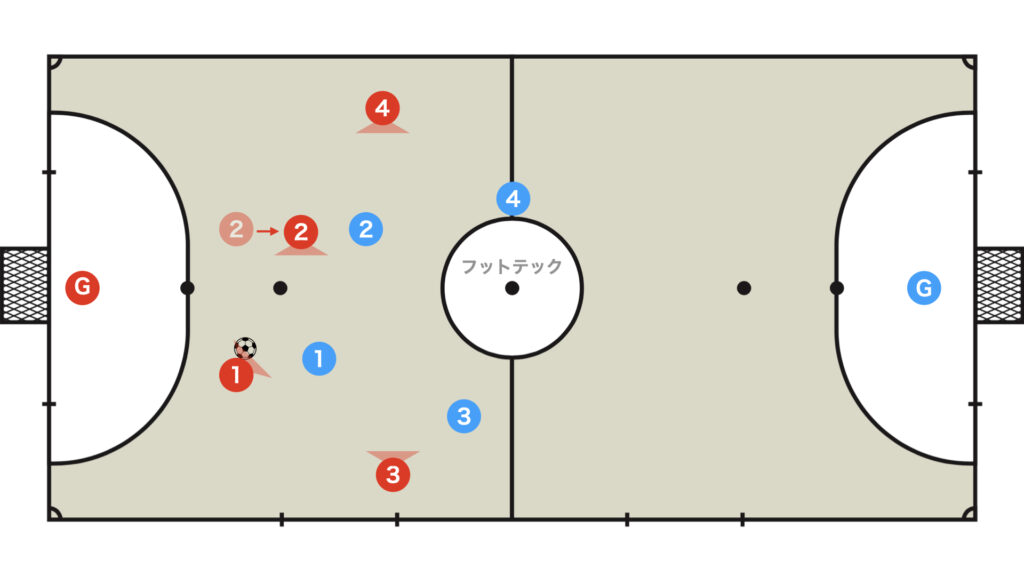

The initial position can be mainly considered in two patterns: bowl shape or 3-on-line+1.
In the bowl shape, it eventually forms 3-on-line+1 as shown above.
Formation of 3-on-line
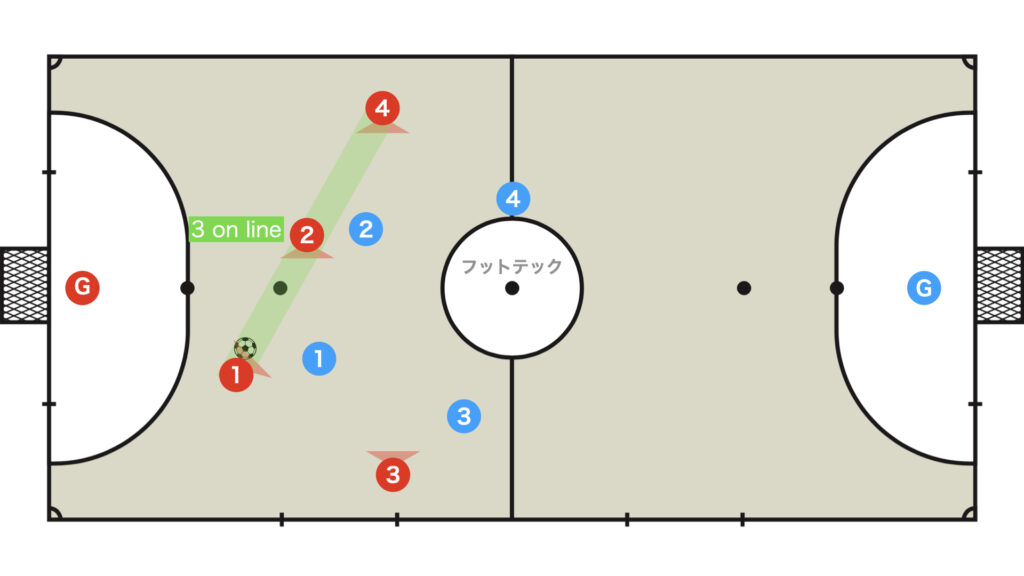

The purpose of 3-on-line is to engage the opponent’s defense with 3-on-line, absorbing and breaking the multiple lines formed by the opponent’s defense.
In this situation, all breakdowns of 3-on-line are possible.
It is strongly recommended to read individual articles on 3-on-line for detailed breakdowns, but some representative breakdowns are introduced here.
Side Breakthrough and Skip Pass
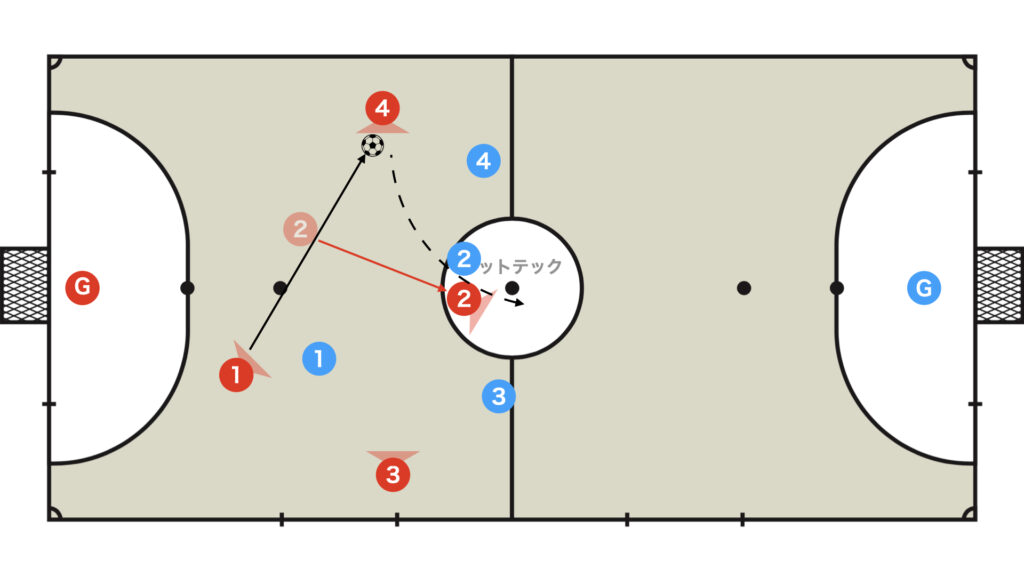

A breakthrough by the central player in 3-on-line to become the third player is a very traditional and well-known move.
Although it may seem like a powerful move, it is entirely ineffective against teams that respond with man-marking switches.
For such opponents, it is recommended to use the backdoor introduced next.
Backdoor Utilizing Man-Marking Switch
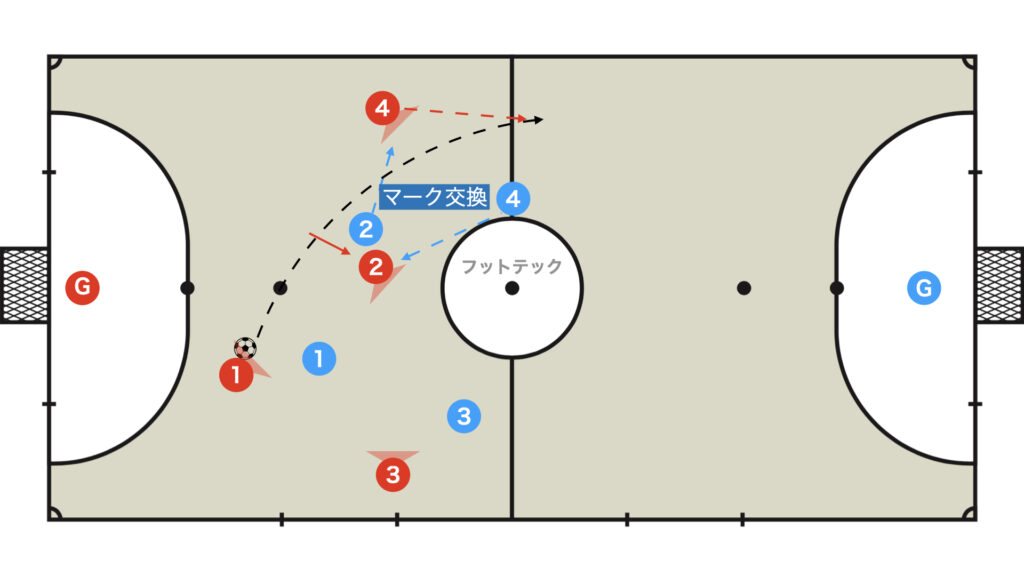

Taking advantage of the opponent’s man-marking switch to target the back. It is very effective against teams that respond with man-marking switches to 3-on-line attacks.
Ala-Corta for Breaking Through Lines
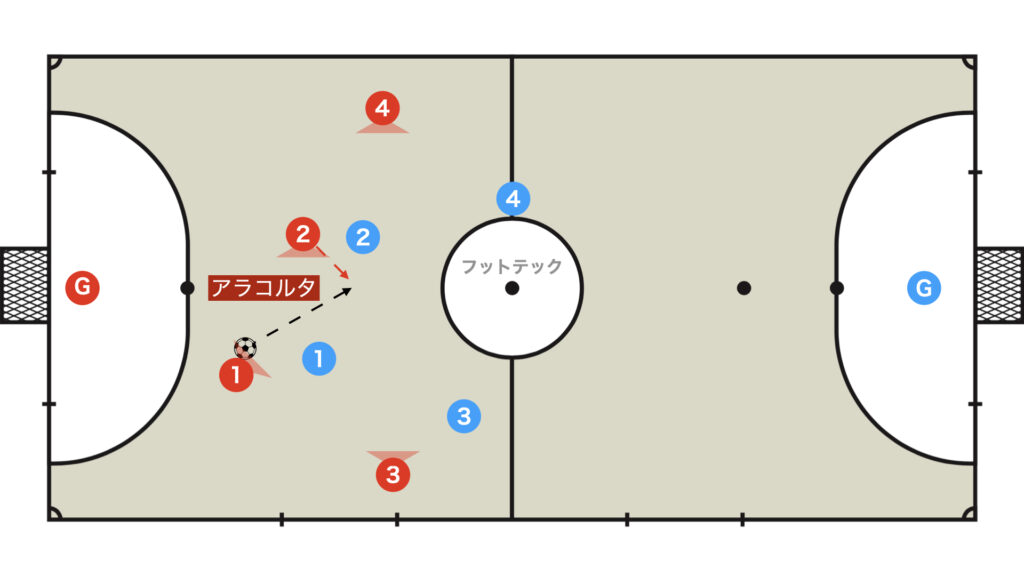

If the opposing defender, Blue 2, tries to intercept a skip pass to Red 4, Ala-Corta becomes effective as the front side becomes open.
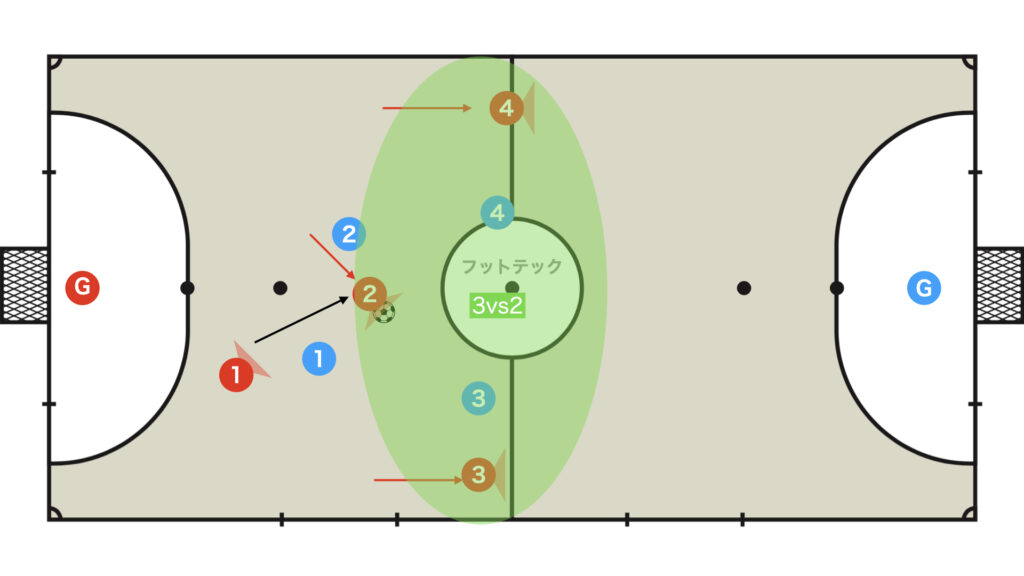

If you can peel off the opponent’s defense with a dribble after receiving with Ala-Corta, you can create a 3vs2 numerical advantage.
Formation of Triangles
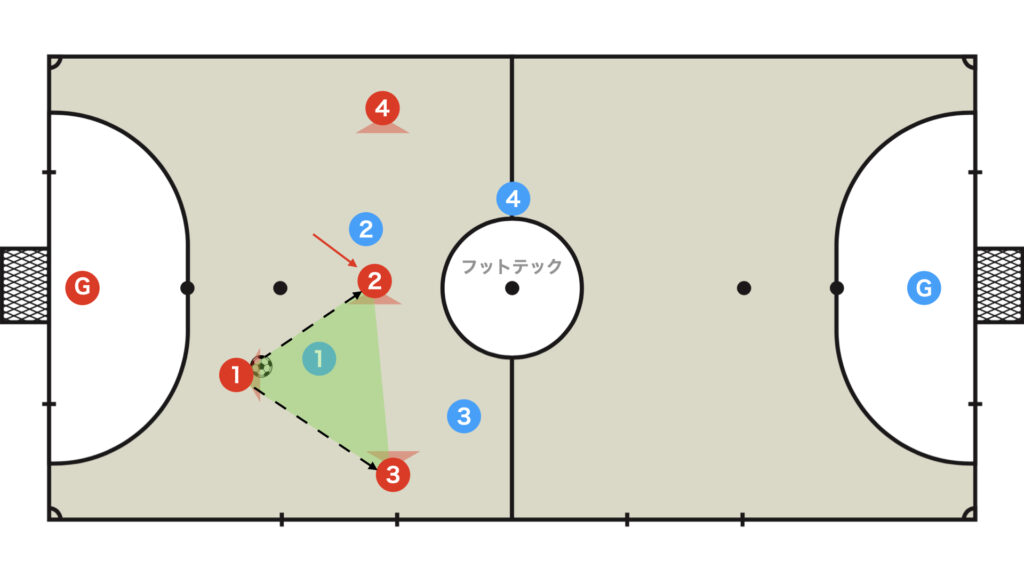

If it’s difficult to break through with 3-on-line, switch the ball to the opposite side.
In the intermediate position of 3-on-line, Red 2 supports Red 3 horizontally.
At this time, it is crucial to keep in mind not to block the passing line from Fixo Red 1 by entering support too early, ensuring the formation of the triangle.
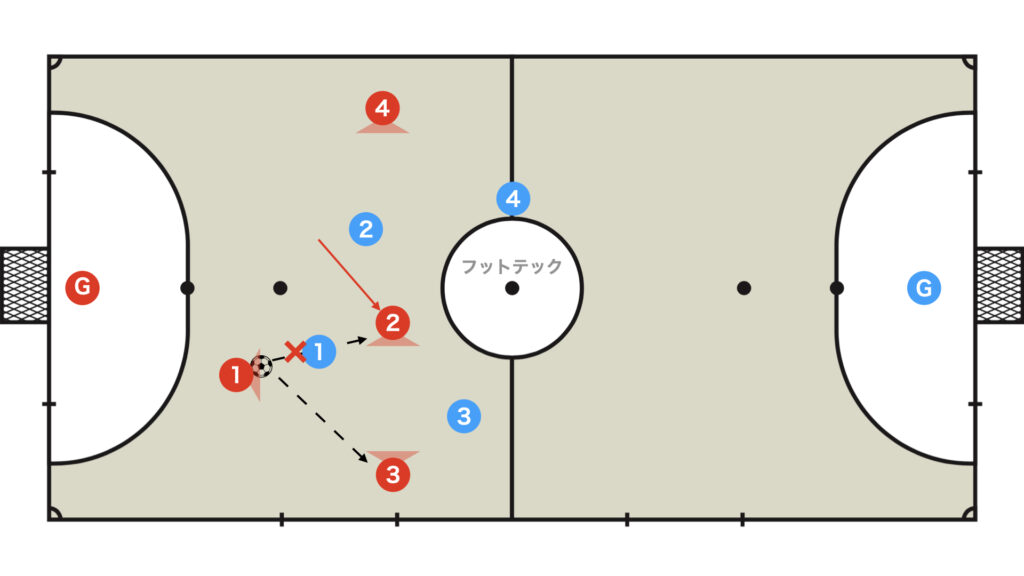

If the passing line from Red 1 to Red 2 is blocked before the ball reaches Red 3 as shown in this figure, Red 1’s options decrease, and the situation becomes challenging.
When switching the ball to the opposite side and forming a triangle, it is crucial for Red 2 to support slowly into the space between the lines while ensuring the passing line from Red 1 is maintained to form continuous passing lines.
Using Entrelinhas (Between Lines)
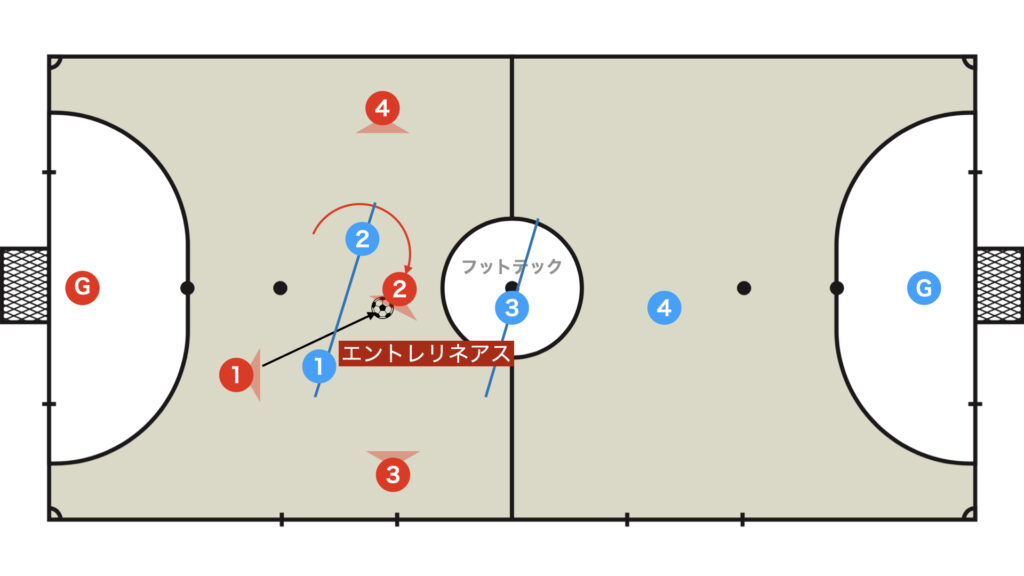

It is effective to utilize the space between the lines, especially if the opponent’s defense is more zonal, with clear man-marking criteria for the first row.
After receiving the ball between the lines, the main options are to turn or pass to Red 3.
Duo Relationships
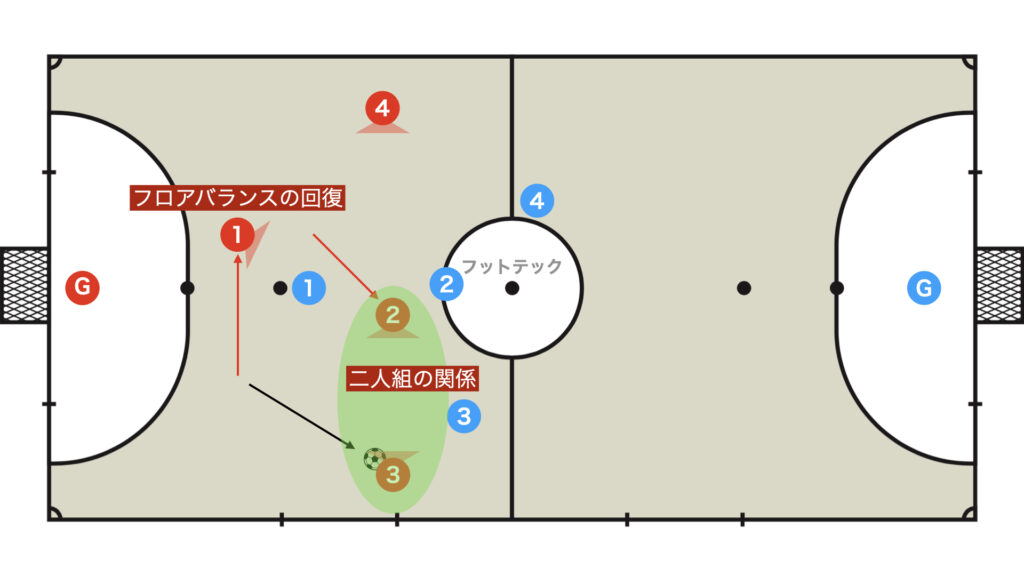

After forming a triangle, Fixo Red 1 passes to Red 2 or Red 3 to create a duo relationship.
- Backdoor (one-two)
- Paralela
- Block or curtain
Triangle +1 Backdoor of the Opposite Ala
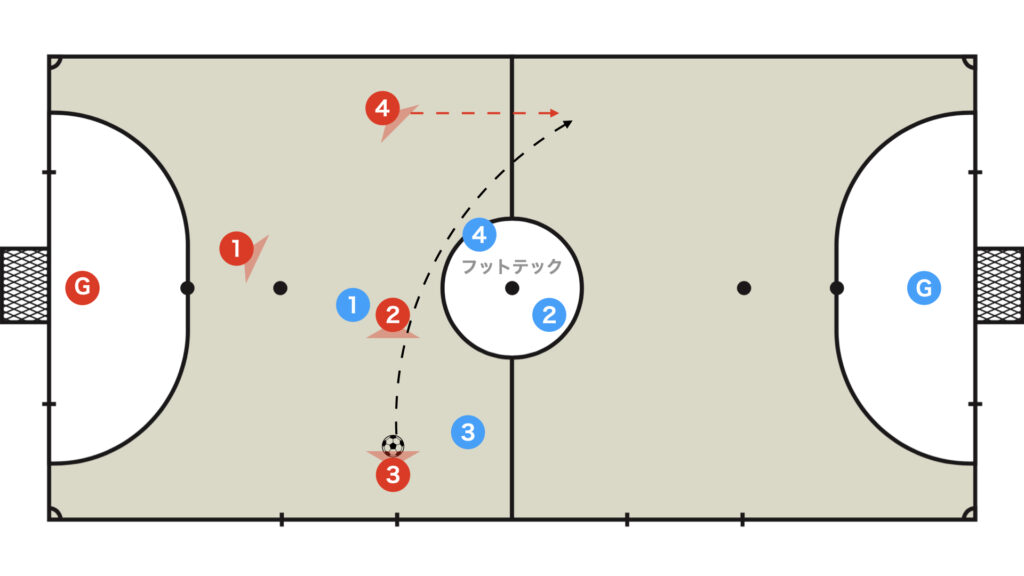

Taking advantage of the space opened by Red 3, Red 1 runs into it, making the backdoor of the opposite Ala effective.
This can be said to be the essence of the four-player rotation Quattro.
Double Breakthrough
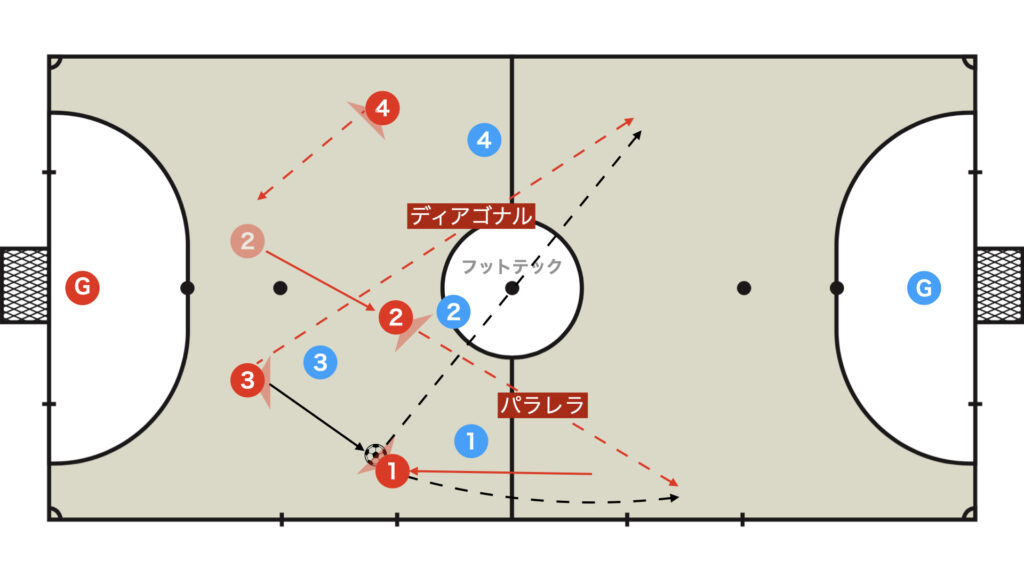

In addition to the paralela of Red 2, if the fixo (axis) breaks through with a diagonal, Red 4 moves back to become the fixo (axis).
It is desirable to decide on in-play signs for double breakthroughs in advance.
③ Reformation of 3-on-Line (Rotation)
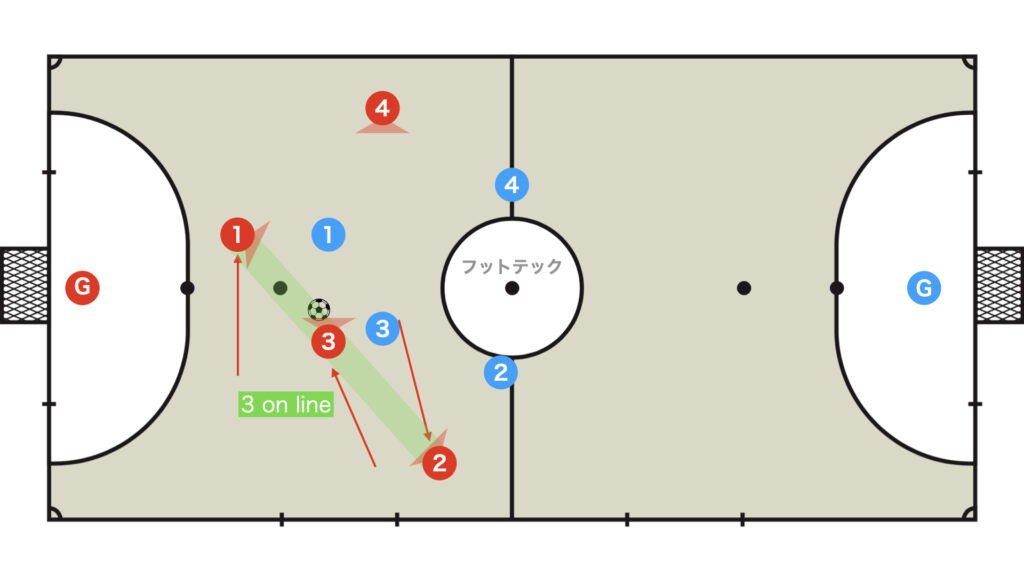

If a breakthrough cannot be made with a duo relationship, reform 3-on-line again and repeat the flow so far.
This rotation is repeated infinitely until a breakthrough is successful.
As you can see, Red 1 is fixed as Fixo, so this series of moves is referred to as a rotation with a fixed Fixo (Quattro with axis).
In this rotation, since the Fixo is fixed, it is an effective tactic when you want to place a specific player in the back and is the most frequently used tactic among professionals.
There are two main benefits to placing a specific player in the back:
- Placing a player with high technical skills at the feet to facilitate ball circulation
- Placing a player good at defense in case of ball loss
④ Four-Player Rotation in Quattro
Overview
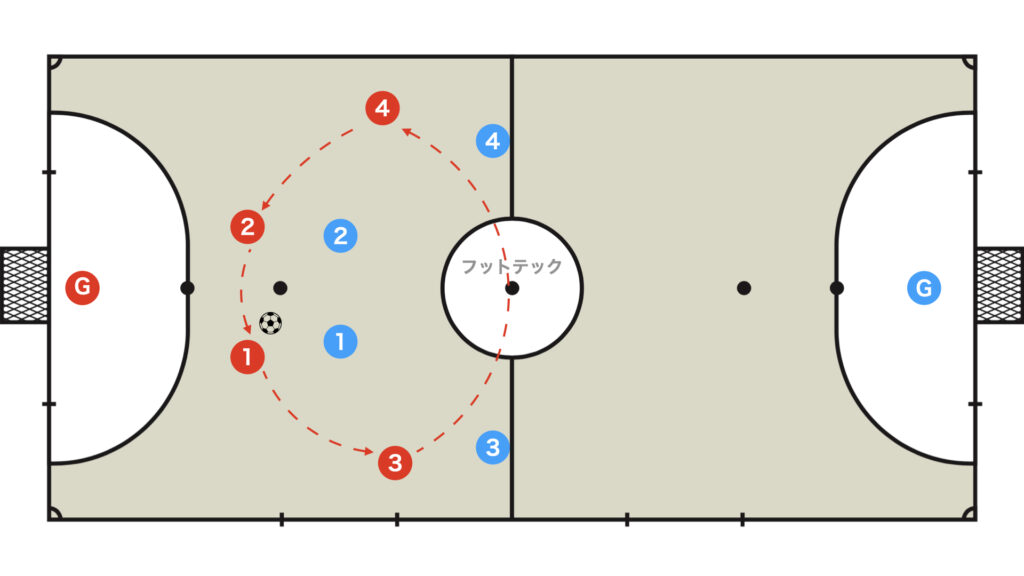

This Quattro tactic involves four players continuously rotating in the same direction, creating continuous triangles (triangles +1).
While Quattro with an axis has a fixed Fixo, in this rotation, everyone can rotate fluidly.
Although it can be done clockwise or counterclockwise, this explanation will be limited to counterclockwise.
It is desirable to decide in advance which direction to rotate, considering the characteristics of the team’s players’ dominant feet.
Initial Setup and Opening
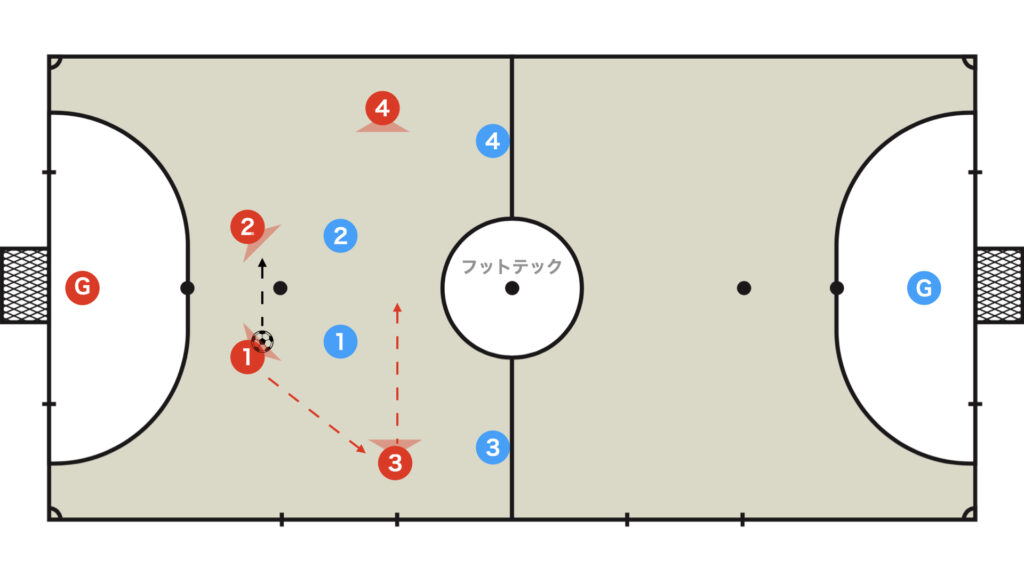

- Pass the ball from Fixo to Fixo
- The opposite Ala enters the space between the lines to form a triangle
- The Fixo (Red 1) who made the pass takes width to restore floor balance
Starting from the initial setup and having someone enter the space between the lines to form a triangle makes it more likely to be targeted, so it’s preferable to start from a bowl shape.
Formation of Triangles
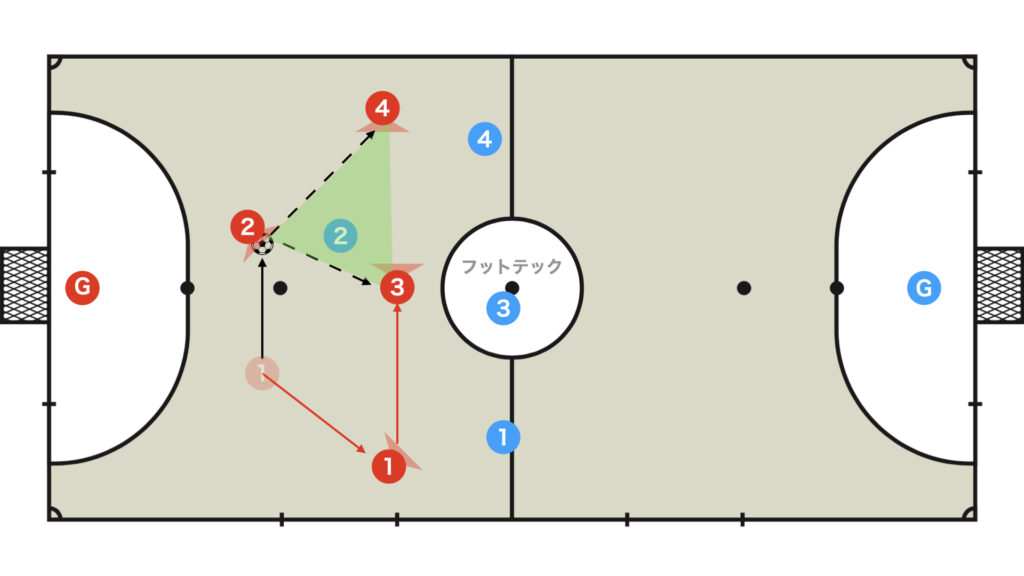

Similar to Quattro with an axis, form a triangle +1.
The essence here is exactly the same as Quattro with an axis.
Triangle +1 Backdoor of the Opposite Ala
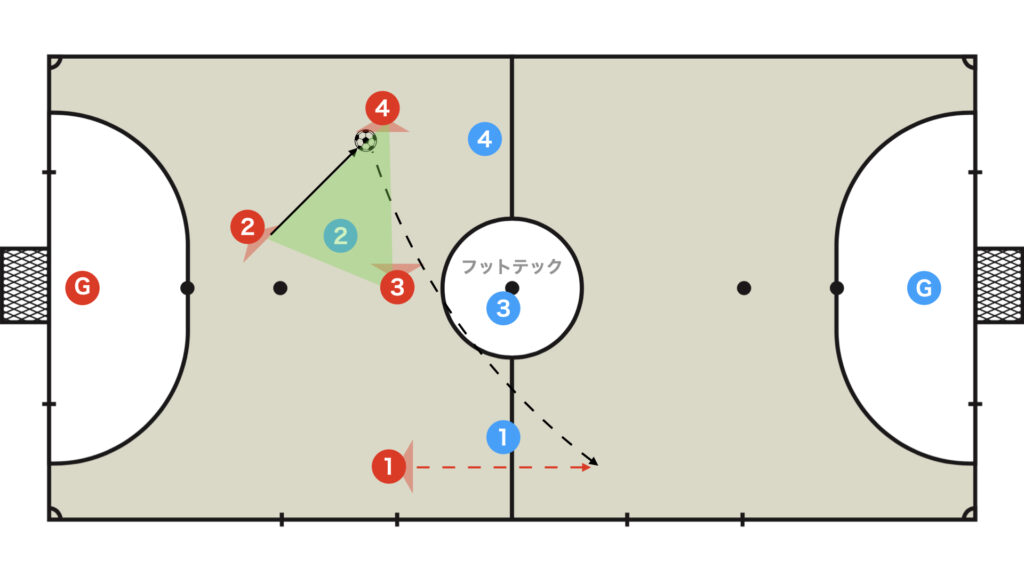

Red 3 vacates the space, and Red 1 runs into it, making the backdoor of the opposite Ala effective.
This is the essence of the four-player rotation Quattro.
Duo Relationships
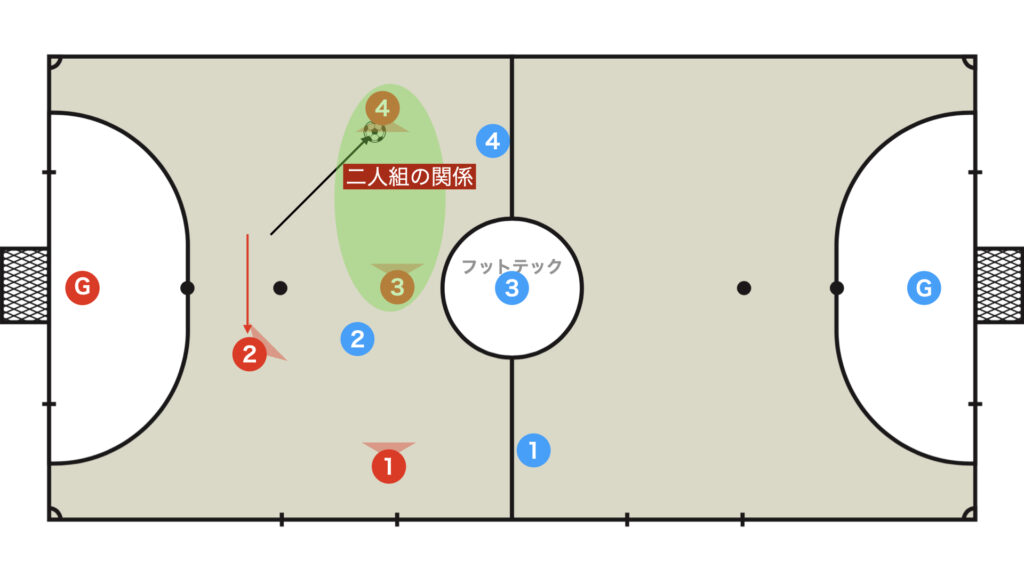

Similarly, attempt to break through with a duo relationship on the side.
If it seems difficult to break through, Red 4 moves to the center, and Red 3 moves to the side lane (where Red 4 was) to return to the original position.
Returning to the Original State
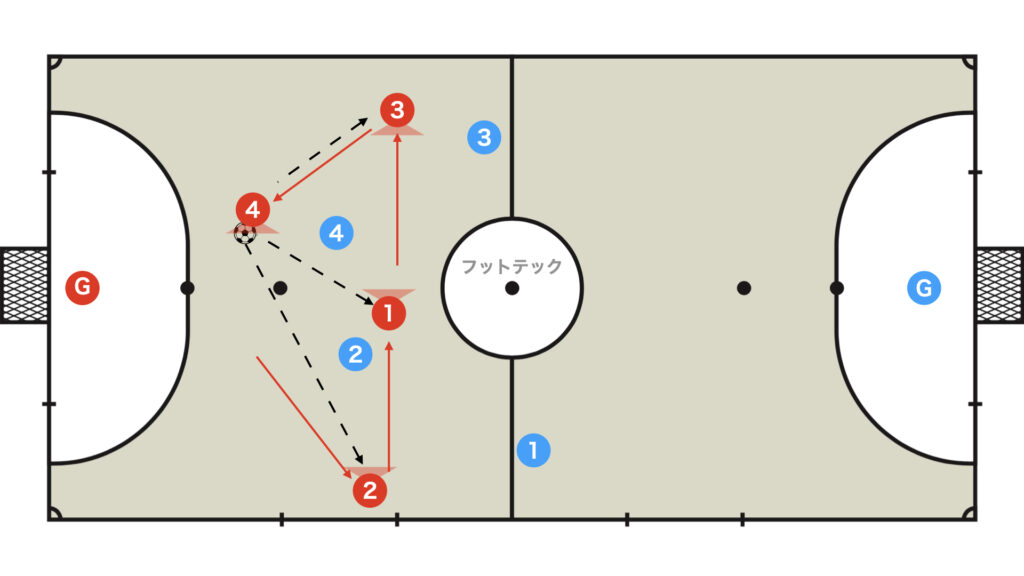

When returning to the original state of triangle +1, three main options can be considered.
Using Entrelinhas (Between Lines)
This is an effective option if the opponent is more zonal.
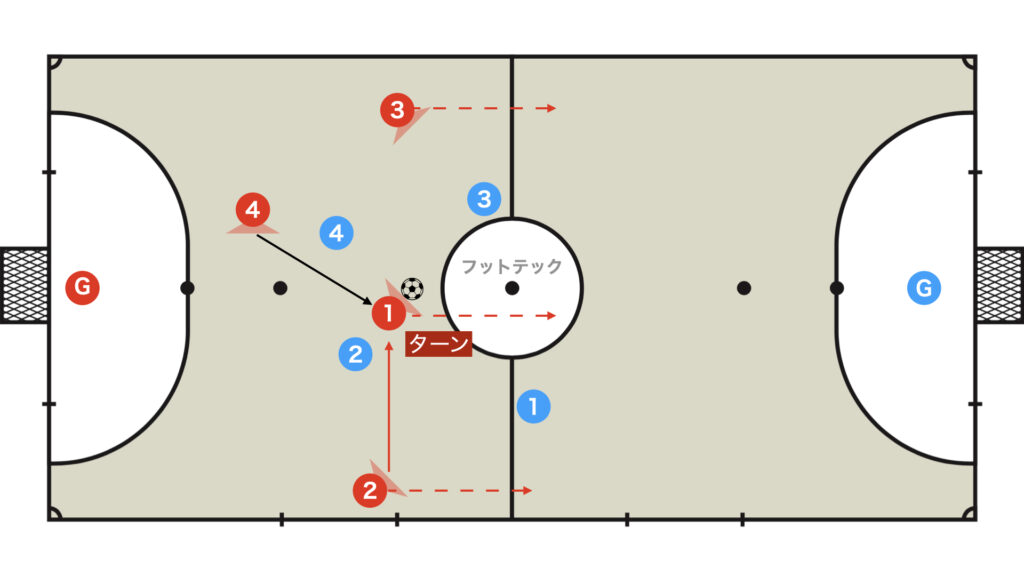

If possible, turn quickly and create a 3vs2.


If turning is not possible, create a duo relationship again.
(At worst, a return pass to Red 4 is also acceptable.)
Using the Opposite Ala
This is the safest option considering Red 4’s body orientation.
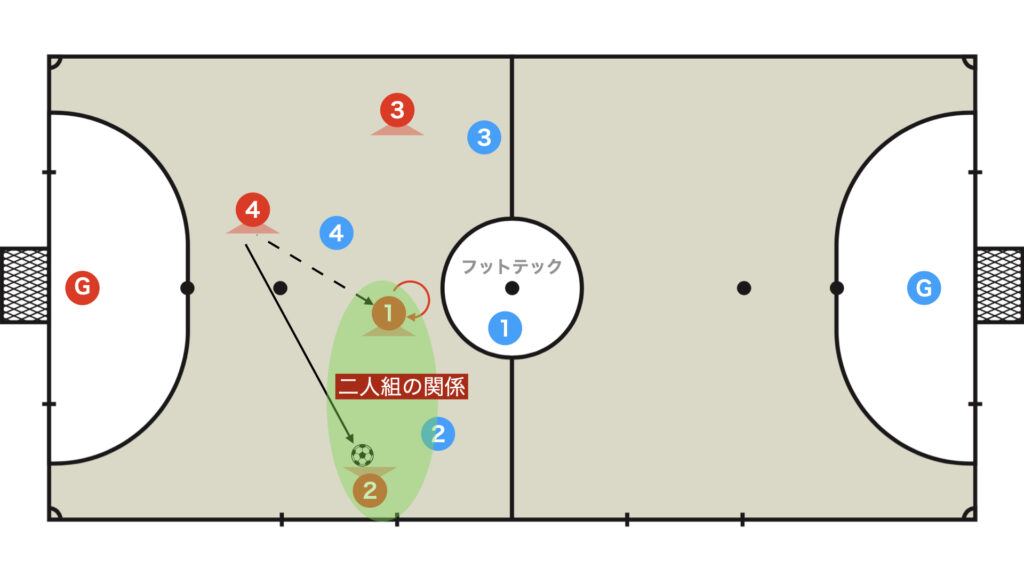

Red 2 and Red 1 create a duo relationship and attempt to break through.
Turn or Pissada to Utilize the Same-Side Ala


If Red 4 dribbles towards the center in a minus direction, Pissada becomes effective.
Supplement: Horizontal 3-on-Line
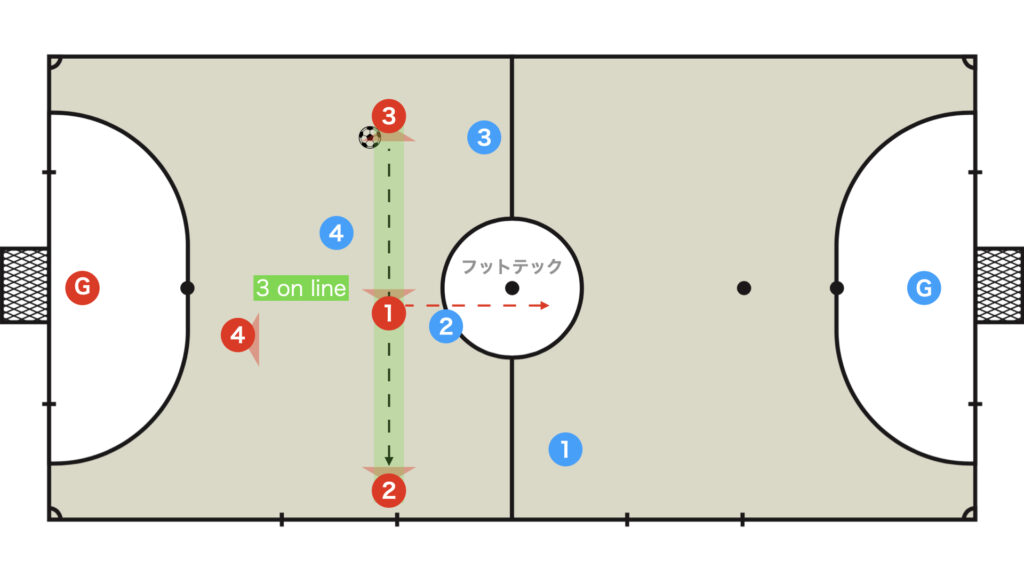

In Quattro with an axis and other formations, creating a duo relationship on the side often results in a horizontal 3-on-line.
In such cases, it is effective for Red 1 to become the third player by ensuring the passing line is secure and then breaking through.
Training Menu for Quattro in Futsal
Four-Lane Division Game



In Quattro zero, it is very important to consider the balance of the configuration with awareness of the four lanes, so it is effective to play games with pitch divided by flat markers or similar constraints.
- Be conscious of having four players in separate lanes (if two players enter the same lane, one exits)
- Game ends if two players stay in the same lane for more than 2 seconds in their own area
[Column] Duo Relationships Are Essential in Futsal Quattro


Since Quattro is a formation formed by four players, it is essential to remember that there are three-player tactics (triangle + 3-on-line) within the Quattro collection, and within that, there are duo relationships and individual tactics.
In other words, to perform high-quality group tactics, it is necessary to work in the following order:
- Individual tactics
- Duo relationships
- Three-player relationships (3-on-line, triangle)
- Quattro
Once you have a general grasp of Quattro, it is desirable to first focus on improving the quality of basic duo relationships.
Basic individual tactics and duo relationships should never be neglected.
Conclusion
This time, we explained the rotations of Quattro.
Although we explained famous fixed tactics, they may not always be the best solution for your team.
It is very important not to blindly imitate but to think and share a play model that suits your team.
Although we did not cover it this time, there are also Quattro tactics that use defensive midfielders, so those with the time should consider it!
By understanding the content of this article, watching F-League matches will change how you view the games, making them much more enjoyable.
Please try to output the content you have inputted somewhere.
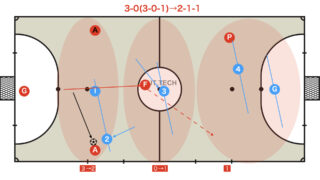

Thank you very much for reading this article to the end.
If you found this article useful, please consider sharing it using the social media share buttons above.
We regularly share valuable insights on futsal tactics on Twitter, so if you haven’t followed us yet, we’d appreciate your support!
We are committed to raising the level of futsal in Japan by sharing high-quality information through discussions with individuals who have coaching experience in the F.League and overseas.
If you have any questions or notice any mistakes, feel free to leave a comment below.
We update our articles regularly, so if you’d like to keep reading, please bookmark our site or search for “FutTech”!
